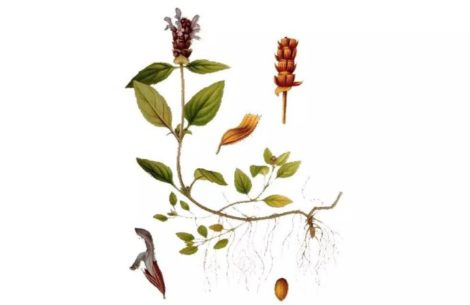Prunella vulgaris is widely distributed in Asia, Europe and North America, and its powers are used to treat inflammation in traditional Chinese medicine (Park, 2010). It is originally recorded in Sheng Nong Ben Cao Jing (Han Dynasty, 1st- 2nd centuries), and has the function: clearing fire, brightening the eyes, clearing the liver, dissipating binds and dispersing swelling. In the clinical practice, it is used to treat tuberculosis, acute jaundice hepatitis, conjunctivitis and high blood pressure, etc. Modern pharmacological studies have shown that Prunella vulgaris has the wide function as: hypoglycemic, antihypertensive, anti-inflammatory, anti-bacterial, anti-virus, anti-mutation, anti-cancer, anti-oxidation, activating blood circulation and transforming stasis (Sun, 2017). It is also edible, and is the main component of Wang Lo Kat herbal tea, a famous and popular drinking originating from Guangdong province in China. However, recently, it is also found to have the potential to improve cognitive performance, with being a major component of YXQNG and having been tested by studies.
In 2010, Park, et al. studied the effects of the ethanolic extract of the power of P. vulgaris var. lilacina (EEPV) on drug-induced learning and memory impairment using the passive avoidance, the Y-maze, and the Morris water maze tasks in mice. The results showed that scopolamine- and MK-801-induced learning and memory dysfunction could be ameliorated by treatment with EEPV. These results suggest that the beneficial effects of EEPV are mediated by enhancement of cholinergic neurotransmitter system via NMDA receptor signaling. Although the findings of this study may not provide clinically useful outcomes in patients or in normal humans, they do suggest that EEPV would be useful for treating diseases that cause cognitive impairments such as Alzheimer’s disease (AD) and schizophrenia.
In 2015, Park, et al. furtherly investigated the effects of EEPV on cognitive ability in normal naive mice and the underlying mechanism(s) governing these effects, including adult hippocampal neurogenesis. The results showed that, in the passive avoidance task, sub-chronic administration of EEPV (25 or 50 mg/kg, p.o.) for 14 days markedly induced the improvement of cognitive function in mice. Moreover, EEPV also significantly increased neural cell proliferation and the number of immature neurons in the hippocampal dentate gyrus. The study results indicated that EEPV may enhance cognitive function via the activation of various intracellular signaling molecules and the up-regulation of adult hippocampal neurogenesis.
As confirmed by Lee, et al, in 2017, they used the in vitro assessment methods to screen the extracts from 35 selected Korean plants, and found that P. vulgaris var. lilacina (aerial part) had the antioxidant and anticholinesterase activity, which indicated that P. vulgaris var. lilacina might be safe and ideal candidates for future AD modifying therapies (Lee, 2017).
Phytochemical research has already identified various bioactive constituents in extracts of P. vulgaris var. lilacina including triterpenoic acids (oleanolic acid, ursolic acid, maslinic acid and prunvuloside A), flavonoids and phenolic compounds (caffeic acid, p-hydroxycinnamic acid, kaempferol, danshensu and rosmarinic acid) (Lee, 2008). Among of them, rosmarinic acid had been tested to have antioxidant effects by suppressing lipoperoxidation and scavenging superoxide radicals, inhibit the formation of b-amyloid (Ab) plaques; caffeic acid was found to have antioxidant and anti-inflammatory activities and was also found to possess a significant protective effect against b-amyloid-induced neurotoxicity by inhibiting calcium influx and tau phosphorylation; Kaempferol had been found to protect PC12 and T47D cells from b-amyloid-induced toxicity. Therefore, the aerial parts of P. vulgaris var. lilacina, with these phytochemicals as the major content, should be further assessed as an adjuvant therapeutic agent for AD (Lee, 2017).
References:
- Lee IlKyun, et al. “Triterpenoic acids of Prunella vulgaris var. lilacina and their cytotoxic activities in vitro.” Arch Pharm Res, Vol, 31, 2008, pp.1578–1583.
- Lee Seulah, et al. “In vitro assessment of selected Korean plants for antioxidant and antiacetylcholinesterase activities.” Pharmaceutical Biology, Vol.55, 2017, pp.2205-10.
- Park Sejin, et al. “The ameliorating effect of the extract of the ?ower of Prunella vulgaris var. lilacina on drug-induced memory impairments in mice.” Food and Chemical Toxicology, Vol. 48, 2010, pp. 1671-6.
- Park Sejin, et al. “Standardized Prunella vulgaris var. lilacina Extract Enhances Cognitive Performance in Normal Naive Mice.” PHYTOTHERAPY RESEARCH, Vol. 20, 2015, pp.1814-21.
- Sun Cheng. “A review on pharmacological effects of Xiakucao.” Clinical Journal of Chinese Medicine, Vol.9 (26), 2017, pp.146-8 (in Chinese).

